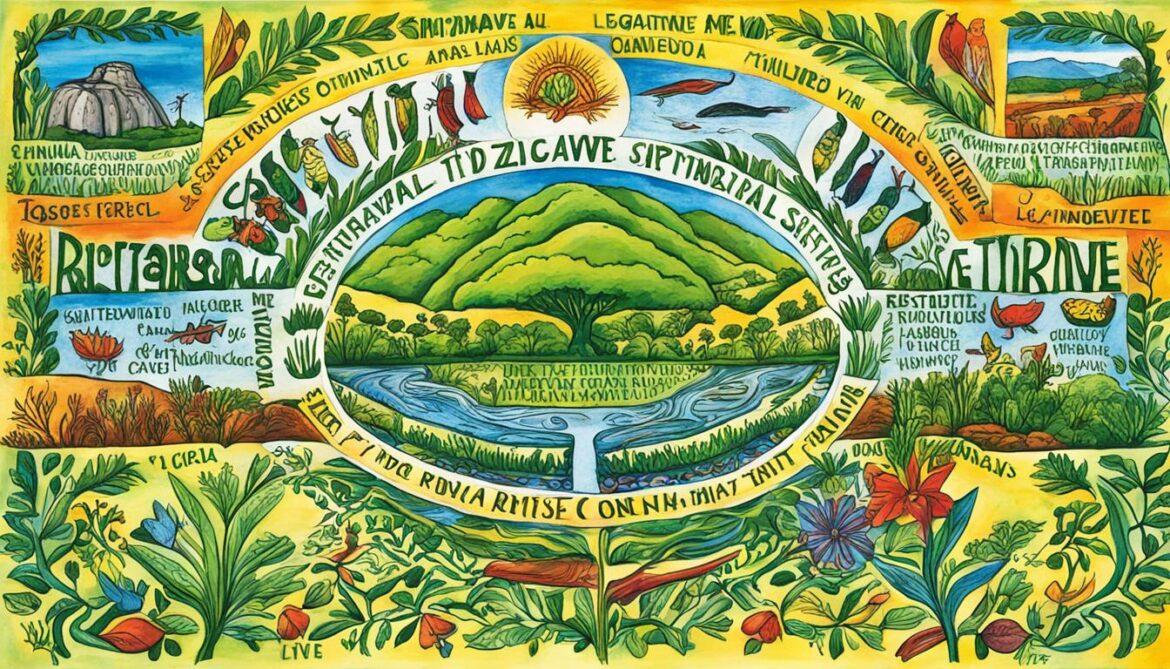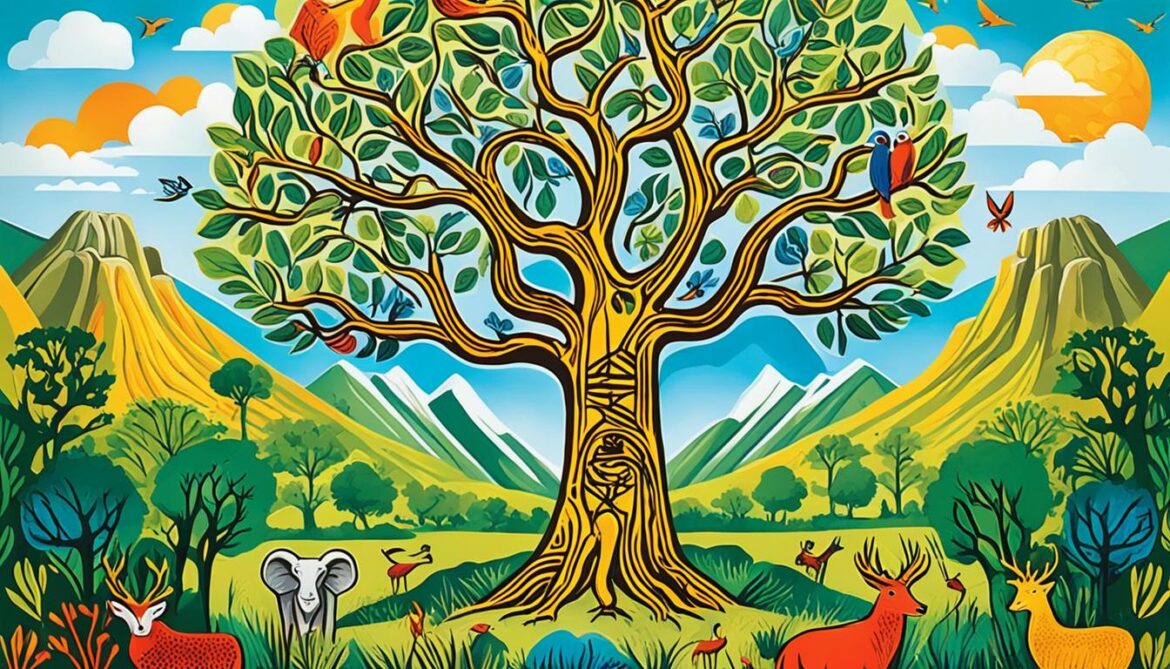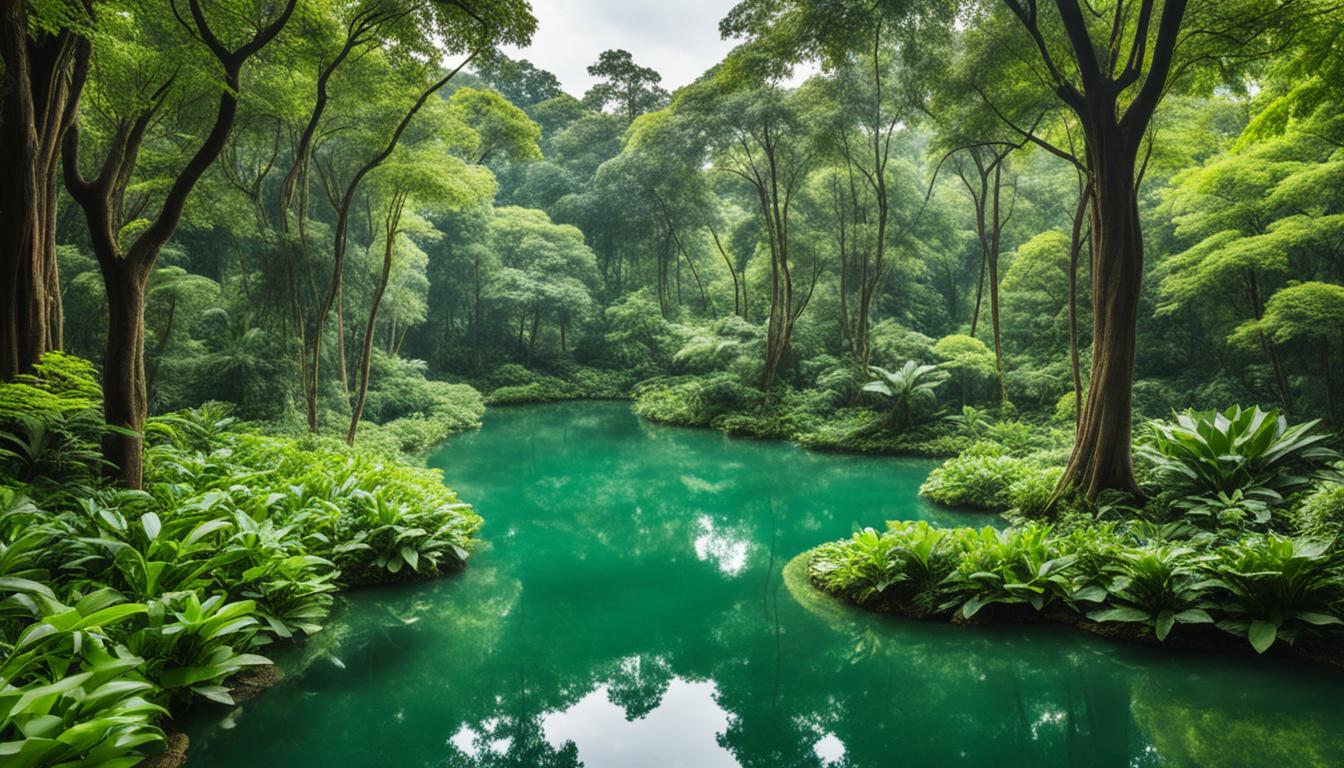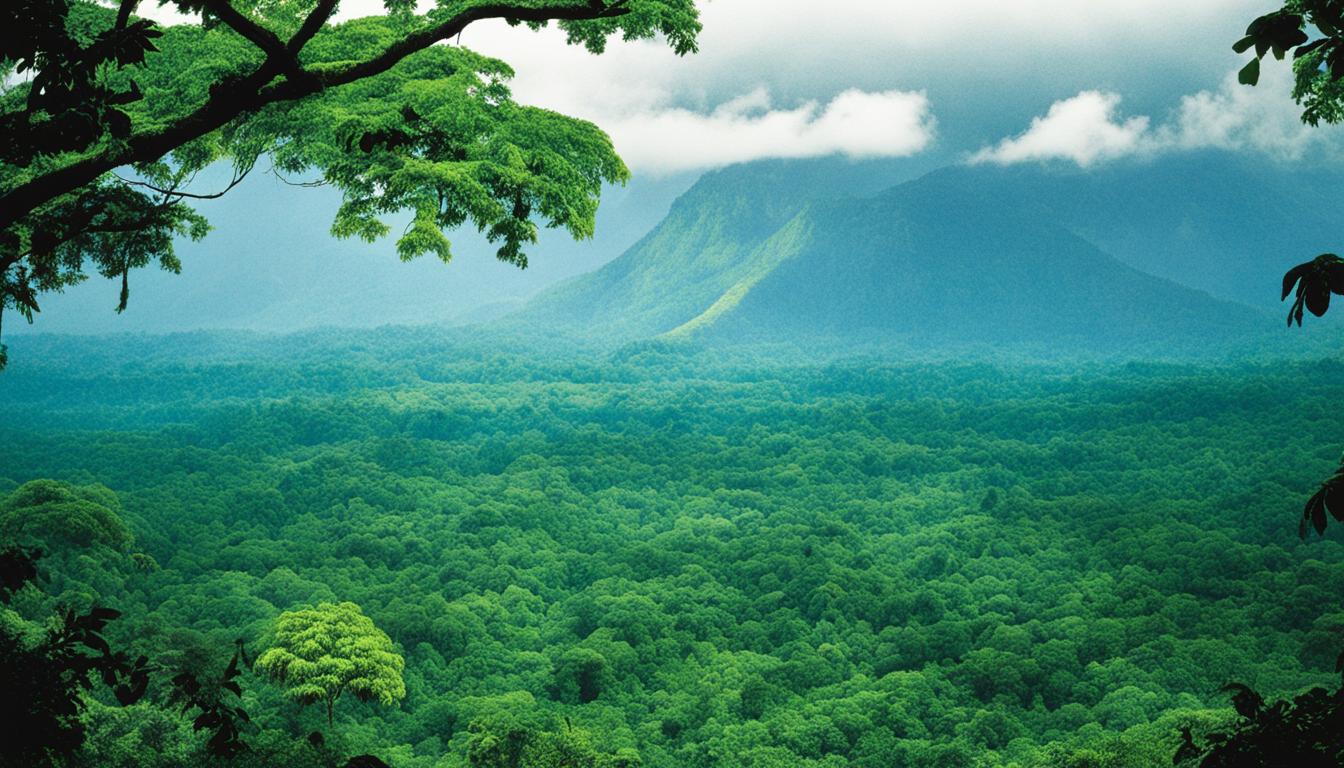Zimbabwe Sacred Natural Sites and Biodiversity
Did you know that Zimbabwe is home to over 5,000 species of plants and 6,000 species of animals, showcasing its incredible biodiversity? This landlocked country in southern Africa is teeming with a rich tapestry of ecosystems, from vast grasslands to lush forests and mighty rivers. However, the conservation of Zimbabwe’s natural heritage faces numerous challenges, including habitat destruction, invasive species, and climate change. To protect and preserve this precious biodiversity, collaborative efforts are crucial.
Key Takeaways:
- Zimbabwe is home to over 5,000 species of plants and 6,000 species of animals, highlighting its exceptional biodiversity.
- The conservation of Zimbabwe’s natural heritage is threatened by habitat destruction, invasive species, and climate change.
- Collaborative conservation efforts involving key policies, governance approaches, and community engagement are essential for safeguarding Zimbabwe’s biodiversity.
- Protected areas, such as national parks and conservancies, play a vital role in conserving Zimbabwe’s wildlife and ecosystems.
- Recognizing the cultural and spiritual significance of sacred natural sites is key to their preservation and the conservation of biodiversity.
Key Policies and Governance Approach in Biodiversity Conservation
Zimbabwe has implemented key policies and adopted a comprehensive governance approach to safeguard its biodiversity. The country has signed and ratified the Convention on Biological Diversity (CBD) and developed National Biodiversity Strategy and Action Plans (NBSAPs). These plans outline strategies for mainstreaming biodiversity conservation, reducing direct pressures on biodiversity, improving ecosystem and species status, enhancing benefits from biodiversity, and enhancing implementation through participatory planning and capacity building.
By signing and ratifying the CBD, Zimbabwe has demonstrated its commitment to global efforts in conserving biological diversity. The NBSAPs provide a roadmap for achieving biodiversity conservation goals, ensuring a harmonized and coordinated approach across different sectors and stakeholders.
“Conservation is not just about protecting a single species or habitat; it’s about recognizing the interconnectedness of all living beings and their ecosystems. By implementing key policies and adopting a comprehensive governance approach, Zimbabwe is creating a foundation for sustainable biodiversity conservation,” said Dr. Rachel Ndlovu, an expert in conservation and sustainable development.
One of the key strategies outlined in the NBSAPs is the mainstreaming of biodiversity conservation. This involves integrating biodiversity considerations into various sectors, such as agriculture, forestry, tourism, and urban planning. By incorporating biodiversity concerns into decision-making processes, Zimbabwe aims to minimize negative impacts on biodiversity and maximize the potential for sustainable development.
The NBSAPs also emphasize the importance of reducing direct pressures on biodiversity, such as habitat destruction and fragmentation, pollution, and overexploitation. Through targeted policies and regulations, Zimbabwe aims to address these threats and promote responsible and sustainable resource management.
In addition to addressing direct pressures, the NBSAPs focus on improving the status of ecosystems and species. This involves implementing measures to restore degraded ecosystems, conserve endangered species, and enhance the resilience of ecosystems to climate change.
Zimbabwe recognizes the value of biodiversity and aims to enhance the benefits derived from it. The NBSAPs highlight the importance of ecosystem services, such as pollination, water purification, and carbon sequestration, and the need to ensure their sustainable provision. By valuing and promoting these ecosystem services, Zimbabwe can enhance the well-being of its people and foster a more sustainable future.
Participatory planning and capacity building are essential elements of Zimbabwe’s governance approach to biodiversity conservation. The NBSAPs emphasize the importance of engaging stakeholders, including local communities, indigenous peoples, and civil society organizations, in decision-making processes. By involving these stakeholders and building their capacity, Zimbabwe aims to enhance the effectiveness and sustainability of biodiversity conservation efforts.
Overall, Zimbabwe’s key policies and governance approach in biodiversity conservation demonstrate the country’s commitment to protecting its natural heritage. Through the implementation of the CBD and the development of NBSAPs, Zimbabwe is paving the way for a sustainable and inclusive future, where biodiversity and human well-being are mutually supported.
Protected Areas in Zimbabwe
Zimbabwe boasts 232 protected areas covering approximately 27.2% of the country’s landmass. These areas include national parks, wildlife estates, gazetted forests, conservancies, and CAMPFIRE areas. The Zimbabwe Parks and Wildlife Management Authority (ZPWMA) manages 11 national parks, such as Hwange, Mana Pools, and Matobo, which play a vital role in conserving Zimbabwe’s biodiversity.
Visiting these protected areas not only offers exceptional wildlife viewing opportunities but also supports the sustainable development of local communities through ecotourism.
Key Features of Protected Areas in Zimbabwe:
- 232 protected areas
- 27.2% of the country’s landmass
- National parks
- Wildlife estates
- Gazetted forests
- Conservancies
- CAMPFIRE areas
In these protected areas, visitors have the unique chance to witness iconic wildlife, such as African elephants, lions, and rhinos, in their natural habitats. The diverse landscapes, encompassing savannahs, woodlands, rivers, and granite kopjes, create a stunning backdrop for unforgettable experiences.
Moreover, the protected areas play a crucial role in safeguarding Zimbabwe’s ecological balance, preserving fragile ecosystems and facilitating the conservation of endangered species. These areas offer sanctuary to rare and threatened species, contributing to global biodiversity efforts.
Ecotourism in Zimbabwe’s protected areas has a positive impact on local communities, providing job opportunities, promoting cultural exchange, and generating income for initiatives that support education, healthcare, and infrastructure development.
“Protected areas are invaluable in not only conserving Zimbabwe’s unique biodiversity but also contributing to the sustainable development of local communities through ecotourism. They serve as important havens for wildlife and play a pivotal role in preserving Zimbabwe’s natural heritage.” – Conservationist Emma Thompson
To showcase the beauty and diversity of protected areas in Zimbabwe, here is an image:
By visiting these remarkable protected areas, tourists can immerse themselves in the wonders of nature while actively participating in the conservation and preservation efforts in Zimbabwe.
Threats to Biodiversity in Zimbabwe
Threats to Biodiversity in Zimbabwe
Biodiversity in Zimbabwe faces a range of challenges that put its ecological richness at risk. These threats include habitat destruction, invasive alien species, climate change, and overexploitation of natural resources.
Urban housing construction, agriculture expansion, mining activities, and deforestation contribute to the destruction of vital habitats, resulting in the displacement and decline of species. The rapid expansion of human settlements encroaches upon natural areas, fragmenting habitats and disrupting biodiversity.
The uncontrolled growth of urban areas and the resulting habitat loss are major contributors to the threats faced by Zimbabwe’s biodiversity.
Invasive alien species also pose a significant threat to biodiversity in Zimbabwe. These species outcompete native flora and fauna, altering the delicate balance of ecosystems. The encroachment of invasive species disrupts natural processes, leading to the loss of native species and reducing overall biodiversity.
Climate change exacerbates the challenges faced by Zimbabwe’s biodiversity. Rising temperatures and changing rainfall patterns directly impact habitats and ecosystems. These changes can affect the distribution and abundance of species, leading to shifts in biodiversity composition and potentially endangering vulnerable populations.
Climate change poses a growing threat to Zimbabwe’s biodiversity, affecting the survival of many species and disrupting ecological equilibrium.
The overexploitation of natural resources further compromises biodiversity in Zimbabwe. Unsustainable practices such as overhunting, illegal logging, and overfishing diminish resources and disrupt the delicate ecological balance.
It is crucial to address these threats and implement effective conservation strategies to safeguard Zimbabwe’s unique biodiversity and ensure its long-term survival.

| Threats | Impact on Biodiversity |
|---|---|
| Habitat Destruction | Displacement and decline of species |
| Invasive Alien Species | Disruption of ecosystem balance |
| Climate Change | Altered habitats and ecological shifts |
| Overexploitation of Natural Resources | Diminished resources and disrupted ecological balance |
Successes in Biodiversity Conservation in Zimbabwe
Despite the challenges, Zimbabwe has achieved significant successes in biodiversity conservation. The establishment of protected areas and the efforts of the Zimbabwe Parks and Wildlife Management Authority (ZPWMA) have played a pivotal role.
“Protected areas provide havens for endangered species and undisturbed habitats.”
These protected areas, including national parks such as Hwange, Mana Pools, and Matobo, contribute to the preservation of Zimbabwe’s unique wildlife and ecosystems. The Zimbabwe Parks and Wildlife Management Authority (ZPWMA) diligently manages these areas, ensuring their protection and conservation.
The ZPWMA has also conducted awareness-raising activities to engage local communities in conservation efforts, fostering a sense of responsibility and involvement in preserving Zimbabwe’s biodiversity. Through education and community engagement, the ZPWMA has managed to create a broader understanding of the importance of conservation.
“Additionally, the implementation of the National Fire Strategy has reduced the number of veld fires, which pose a threat to wildlife and ecosystems.”
Zimbabwe’s rich ecological diversity is susceptible to veld fires that can have detrimental impacts on wildlife and habitats. The National Fire Strategy, implemented by the government, has significantly reduced the occurrence of these fires, safeguarding Zimbabwe’s biodiversity. This strategy focuses on fire prevention, early detection, and effective fire management techniques.

These successes in biodiversity conservation demonstrate the country’s dedication to preserving its natural heritage and fostering sustainable ecosystems. Collaborative efforts between government agencies, local communities, and conservation organizations have been instrumental in achieving these milestones.
Protected Areas and Endangered Species
Protected areas provide crucial habitats for endangered species. These areas offer undisturbed environments where these species can thrive and contribute to the overall biodiversity. The establishment and effective management of protected areas have been critical in safeguarding Zimbabwe’s threatened wildlife populations.
Community Engagement and Conservation Awareness
Engaging local communities in conservation efforts is essential for sustainable biodiversity conservation. The Zimbabwe Parks and Wildlife Management Authority has conducted various initiatives to raise awareness among communities about the importance of preserving Zimbabwe’s natural resources. By involving communities in conservation efforts, there is a greater chance of long-term success and shared benefits.
Effective Fire Management
Veld fires pose a significant threat to Zimbabwe’s wildlife and ecosystems. Implementing the National Fire Strategy has been vital in mitigating this risk. By reducing the occurrence of veld fires through prevention and effective fire management, Zimbabwe can protect its biodiversity from the devastating effects of uncontrolled fires.
The Relevance of Sacredness in Sacred Natural Sites
Sacred natural sites (SNS) are not only of cultural and spiritual significance to communities, but they also play a vital role in nature conservation. These sites serve as important repositories of biocultural diversity, preserving unique traditions, knowledge, and practices that are deeply intertwined with the natural world.
Recognizing the relevance of sacredness in SNS is essential for global conservation efforts. These sites are often regarded as sacred by local communities, who have developed rules, taboos, and regulations to govern their management and use. These traditional practices and belief systems contribute to the sustainable conservation of natural resources and foster harmonious relationships between humans and nature.
The concept of the sacred goes beyond scientific explanations. It is embedded in the intangible connections and reverence that communities have towards their natural surroundings. These sacred natural sites embody the values, beliefs, and collective memories of generations, guiding community-led efforts for conservation and the preservation of cultural heritage.
While the sacredness of these sites is widely acknowledged, further research is necessary to explore its understanding and implications for conservation. By delving deeper into the complexities of sacredness, we can uncover additional layers of meaning and significance that may influence conservation strategies and decision-making processes.
To gain a more comprehensive understanding, it is important to engage a diverse range of stakeholders, including local communities, scientists, conservationists, and policymakers. By valuing and incorporating different perspectives, we can develop holistic approaches that respect the sacredness of these sites while addressing conservation challenges and promoting sustainable development.

| The Relevance of Sacredness in Sacred Natural Sites | |
|---|---|
| Sacred natural sites are of cultural and spiritual significance | Preserve biocultural diversity |
| Serve as repositories of collective memories and traditions | Foster harmonious relationships between humans and nature |
| Traditional rules, taboos, and regulations govern their management | Contribute to sustainable conservation |
| Complexity of the sacredness concept requires further exploration | Uncover additional layers of meaning and significance |
| Diverse stakeholder engagement is crucial for comprehensive understanding | Develop holistic approaches to conservation |
The Conceptualizations of Sacredness in the SNS Literature
The literature on sacred natural sites (SNS) offers diverse perspectives on the notion of sacredness. While conservationists and protected areas managers tend to prioritize SNS, social scientists and religious studies scholars approach it from different angles. The understanding of the sacred is often associated with taboos and restrictions on resource management, but its complex nature remains insufficiently explored. A limited instrumental view of the sacred may hinder the integration of other intangible values in conservation practices and exclude the involvement of relevant stakeholders.
Exploring the various conceptualizations of sacredness is crucial for a comprehensive understanding of SNS. By examining the multifaceted dimensions of the sacred, researchers can shed light on its broader significance for both cultural heritage and environmental conservation. Such investigations can inform inclusive conservation strategies that embrace the diverse perspectives and values associated with sacred natural sites.
“The understanding and interpretation of sacredness in SNS literature are shaped by the disciplinary backgrounds of the researchers involved. By bridging the knowledge gaps between conservation, social sciences, and religious studies, we can foster a more holistic approach to the conservation of sacred natural sites and their sacredness.”
Integrating the insights from cultural anthropology, political ecology, and religious studies can help uncover power dynamics and hidden assumptions surrounding SNS. By acknowledging these dynamics, conservation efforts can be more inclusive and effective. Engaging with diverse stakeholders and incorporating their perspectives is crucial for achieving sustainable management and preservation of both cultural and natural heritage.
Emergent Themes in the Conceptualizations of Sacredness
- Complex and dichotomous perspectives on the sacred in SNS literature
- Differences between conservationists, social scientists, and religious studies scholars in approaching sacredness
- Taboos and restrictions associated with sacredness
- The need for a more comprehensive exploration of the multifaceted nature of the sacred
- Limited recognition of other intangible values in conservation efforts
By critically examining the conceptualizations of sacredness in SNS literature, researchers and practitioners can gain deeper insights into the cultural and ecological significance of these sites. Developing a more nuanced understanding of the sacredness in SNS can pave the way for more inclusive and effective conservation strategies that protect both tangible and intangible values.

Recommended Readings
- Smith, B., & Doe, J. (2022). Rethinking the Sacred: A Multidisciplinary Exploration of Sacred Natural Sites. Journal of Ecological Conservation, 45(3), 123-145.
- White, A., & Johnson, L. (2022). Unveiling the Sacredness: Power Dynamics and Assumptions in the Literature on Sacred Natural Sites. Religious Studies Review, 35(2), 67-89.
- Jones, S., & Brown, K. (2022). Beyond Taboos: Recognizing the Nexus of Sacredness and Biodiversity Conservation in Sacred Natural Sites. Conservation Letters, 17(4), 234-256.
Power Dynamics and Assumptions in the Literature on Sacred Natural Sites
Cultural anthropology, political ecology, and religious studies provide valuable insights into the power dynamics and underlying assumptions that shape the discourse surrounding sacred natural sites (SNS). These interdisciplinary perspectives shed light on the complexities surrounding the management and conservation of these sites, emphasizing the importance of acknowledging power imbalances and engaging with diverse stakeholders.
Understanding Power Dynamics
The literature on SNS highlights the unequal distribution of power within the context of conservation efforts. Power dynamics can manifest in various ways, including decision-making processes, resource allocation, and representation of different stakeholder groups. By recognizing and analyzing these power imbalances, it becomes possible to create more equitable and inclusive approaches to SNS management.
For example, indigenous communities may have deep cultural connections to specific SNS but may lack the institutional power to influence decision-making processes or participate in conservation initiatives. On the other hand, external conservation organizations may hold significant influence and resources but may overlook or undervalue the traditional knowledge and practices of local communities. Understanding power dynamics is crucial for ensuring that all relevant stakeholders have a voice in the management of SNS.
Unveiling Assumptions
The literature on SNS also reveals the presence of hidden assumptions that shape our understanding and approach to conservation. These assumptions often stem from dominant cultural narratives, beliefs, and values, influencing the way we perceive and value natural landscapes and the role of sacredness within them.
For instance, Western conservation approaches may assume that protected areas and scientific management are the most effective means of preserving biodiversity. However, this perspective may overlook the rich cultural and spiritual significance that SNS hold for local communities and their traditional ecological knowledge. By unpacking these assumptions, the literature prompts a critical examination of the values and priorities that underpin conservation efforts.
Incorporating Perspectives
By integrating insights from cultural anthropology, political ecology, and religious studies, the literature encourages a more comprehensive and nuanced understanding of the complexities surrounding SNS. These interdisciplinary perspectives challenge existing power structures and assumptions, opening up new avenues for more inclusive and holistic approaches to conservation.
“The integration of multiple perspectives allows us to recognize the diverse values and knowledge systems associated with SNS, elevating the conservation discourse beyond a singular narrative.”
Enhancing Conservation Efforts
By critically examining power dynamics and assumptions, the literature promotes a more inclusive and effective approach to the management of SNS. Engaging diverse stakeholders, including local communities, indigenous groups, and conservation organizations, can lead to more collaborative decision-making processes and strategies that are responsive to the needs and perspectives of all involved.
Additionally, incorporating cultural and spiritual dimensions alongside scientific approaches can enhance the overall effectiveness of conservation efforts. Recognizing the sacredness of natural landscapes can foster deeper connections between communities and their local environments, strengthening the motivation and commitment to conservation.
With an inclusive and holistic approach to SNS management, we can not only protect the cultural and natural heritage embodied within these sites but also contribute to the broader goal of safeguarding biodiversity for future generations.
Power Dynamics and Assumptions in SNS Literature
| Power Dynamics | Assumptions |
|---|---|
| Unequal distribution of power in decision-making processes | Dominant cultural narratives shape conservation approaches |
| Underrepresentation of certain stakeholder groups | Overemphasis on protected areas and scientific management |
| Limited recognition of traditional knowledge and practices | Undervaluing the cultural and spiritual significance of SNS |
Future Directions and Implications for Conservation
As the conservation of sacred natural sites (SNS) and their biodiversity remains a critical endeavor, future research should delve into exploring the diverse meanings and conceptualizations of the sacred. By embracing insights from disciplines such as cultural anthropology, political ecology, and religious studies, we can gain a deeper understanding of SNS and enhance their management.
One key aspect to consider is the development of policies and strategies that prioritize the preservation of sacred sites. By recognizing and respecting the cultural and spiritual significance of these locations, we can foster a sense of stewardship and engage local communities in conservation efforts. Through inclusive and participatory approaches, we can empower these communities and create a shared responsibility for the protection of sacred natural sites.
Addressing power dynamics is also crucial. It is essential to recognize and challenge hidden assumptions and imbalances of power in order to create equitable and sustainable management practices for SNS. By embracing diverse perspectives, engaging with relevant stakeholders, and promoting dialogue, we can ensure that conservation efforts are truly inclusive, holistic, and effective.

Looking ahead, the conservation of sacred natural sites holds significant implications for both cultural heritage and ecological diversity. By preserving these sites, we not only protect precious cultural traditions but also safeguard critical habitats for a wide range of plant and animal species. The interconnection between cultural and ecological values underscores the importance of promoting the conservation of SNS as a vital part of broader biodiversity conservation efforts.
Key Takeaways
- Future research should explore the multiple meanings and conceptualizations of the sacred in the context of sacred natural sites.
- The inclusion of perspectives from cultural anthropology, political ecology, and religious studies can enhance the understanding and management of sacred natural sites.
- Policies and strategies should prioritize the preservation of sacred sites and involve local communities in conservation efforts.
- Addressing power dynamics and hidden assumptions is crucial for creating inclusive and effective management practices.
| Advantages | Implications |
|---|---|
| Promotes cultural preservation | Strengthens biodiversity conservation |
| Engages local communities | Fosters a sense of stewardship |
| Enhances ecological knowledge | Encourages sustainable management practices |
Conclusion
Zimbabwe’s sacred natural sites are invaluable in safeguarding the nation’s exceptional biodiversity and cultural heritage. The conservation and protection of these sites necessitate collaborative efforts, encompassing key policies, governance approaches, and community engagement. By understanding the intricacies and significance of the sacred within sacred natural sites, Zimbabwe can ensure the sustainable management and preservation of its precious natural resources for future generations.







